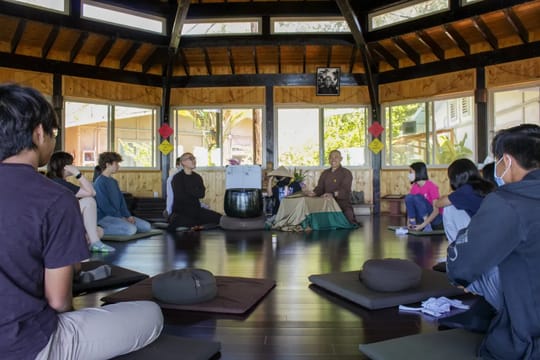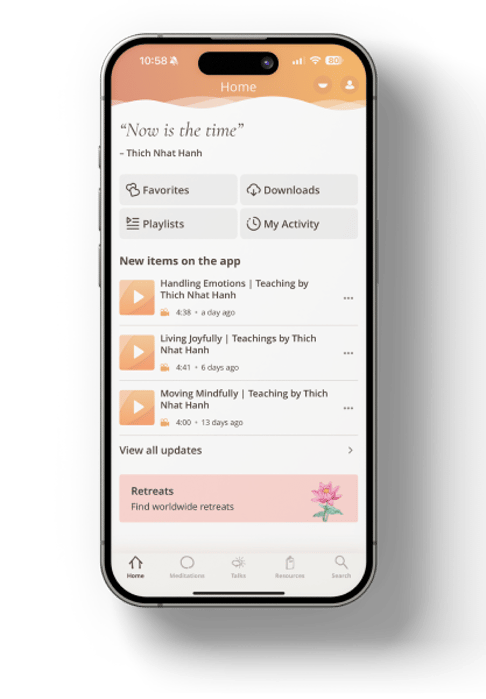Many of us carry a wounded child within. When we were children, we suffered deep wounds in our hearts. These wounds make it difficult for us to trust and love others, as well as to accept their love in return. We must take the time to return and care for this inner child. This practice is essential. However, when practicing this, we may face many obstacles. Many of us know that we have a wounded child within, but we are afraid to face ourselves and the wounded child within. The burden of sorrow and pain is so great, it dominates our hearts, making us afraid to confront it, and we may feel the urge to escape. Yet, no matter how difficult it may be, we must return to care for the wounded child within. It may help to seek guidance from those with experience to prevent the pain from overwhelming us.
Practice
Practicing walking meditation, sitting meditation, and mindful breathing are the fundamental and essential practices. The energy of mindfulness from fellow practitioners can support us greatly. Perhaps when we first return to the wounded child within, we may need one or two companions, particularly those who have succeeded in this practice, to sit beside us, support us, and offer their energy and mindfulness. When a friend holds our hand, the energy from both of us combines to create a power that helps us feel safe enough to embrace the wounded child within.
While sitting or walking in meditation, we should speak to that child several times a day. Only then will healing begin. The child has been left alone for too long. Therefore, we must begin the practice now. Gently embrace the child and promise that we will never abandon it, allowing it to deteriorate again. If we have a Sangha, our practice will be much easier than practicing alone without the support of our brothers and sisters. Leaning on the Sangha, with brothers and sisters to help, advise, and support us during difficult moments is crucial.
The wounded child within us may represent multiple generations. It is possible that our grandparents or parents had similar issues and also carried their own wounded child within, not knowing how to embrace and transform it. Therefore, they passed on their wounded child to us. We must practice to break this cycle. If we heal the wounded child within us, we will release those who have caused us suffering. They may have also been victims of abuse. If we can cultivate mindfulness, understanding, and compassion for the wounded child within us, we will relieve much of our suffering. People suffer because they cannot understand and love. When we cultivate mindfulness, understanding and love arise naturally. We can accept love from others. Where we once doubted everyone and everything, now compassion will help us communicate and rebuild connections with others.
Guided Meditation on "The Wounded 5-Year-Old Child"
Breathing In, I see myself as a 5-year-old child. Breathing out, I smile at the 5-year-old child that I am.
In, seeing the child / Out, smiling at the child.
Breathing In, I see the 5-year-old child within me as fragile and lovable. Breathing out, I smile at the child within me with understanding and compassion.
In, the child is fragile, so lovable / Out, smiling with understanding and compassion.
Breathing In, I see my father as a 5-year-old child. Breathing out, I smile at my father as a 5-year-old child.
In, my father as a 5-year-old child / Out, smiling at my father as a 5-year-old child.
Breathing In, I see the 5-year-old child within my father as fragile and easily hurt. Breathing out, I smile at the child within my father with understanding and compassion.
In, the child within my father is fragile, easily hurt / Out, smiling with understanding and compassion.
Breathing In, I see my mother as a 5-year-old child. Breathing out, I smile at my mother as a 5-year-old child.
In, my mother as a 5-year-old child / Out, smiling at my mother as a 5-year-old child.
Breathing In, I see the 5-year-old child within my mother as fragile and easily hurt. Breathing out, I smile at the child within my mother with understanding and compassion.
In, the child within my mother is fragile, easily hurt / Out, smiling with understanding and compassion.
Breathing In, I see the suffering of my father when he was 5 years old. Breathing out, I see the suffering of my mother when she was 5 years old.
In, father’s suffering at age 5 / Out, mother’s suffering at age 5.
Breathing In, I see my father within me. Breathing out, I smile at my father within me.
In, my father within me / Out, smiling at my father within me.
- Breathing In, I see my mother within me. Breathing out, I smile at my mother within me. In, my mother within me / Out, smiling at my mother within me.
Breathing In, I understand the difficulties my father has within me. Breathing out, I vow to transform both my father and myself.
In, father’s difficulties within me / Out, transforming both father and me.
Breathing In, I understand the difficulties my mother has within me. Breathing out, I vow to transform both my mother and myself.
In, mother’s difficulties within me / Out, transforming both mother and me.
In the beginning, let us visualize ourselves as a 5-year-old child. At that age, we are very vulnerable. A sharp look, a raised voice, or a harsh word can cause lasting harm and a sense of shame. When father harms mother or mother harms father, or when they harm each other, seeds of suffering are planted and watered in the heart of the child. Growing up, the child carries much unresolved pain and lives with resentment toward father, mother, or both. By seeing ourselves as such a fragile, easily hurt child, we will feel compassion for ourselves, and that compassion will fill our being. We smile at the 5-year-old child within us with a smile of compassion and tenderness.
Next, we visualize our father or mother as a 5-year-old child. Often, we only see our father as a grown, strict, and powerful man, solving problems with authority. But we know that before becoming an adult, our father was once a 5-year-old boy, as fragile and vulnerable as we were. We see that he was once shy and quiet, fearing his father’s anger, and he too suffered from his father’s wrath. If necessary, we may look at family photos to rediscover the image of our father as a 5-year-old boy, or our mother as a 5-year-old girl. In meditation, we familiarize ourselves with that child and smile kindly at him or her, recognizing their fragility and vulnerability. Compassion naturally arises within us. When compassion flows from our hearts, we know that our insight is beginning to take effect. Understanding leads to love. Our inner pain will gradually transform with this practice. With understanding, we begin to accept. We can then use our understanding and love to help transform our parents. We know we can do this because understanding and compassion have already transformed us, making us more gentle, calm, patient, and loving. Patience and calmness are the signs of true love.





